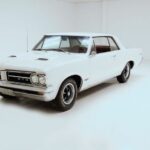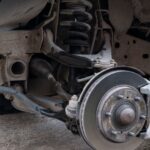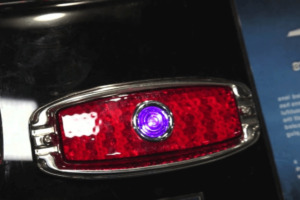What do you call the front of a car? It’s more important than you think. This article will explain everything you need to know about the front of a car.
The front of a car is called the hood (American English) or bonnet (British English). It’s usually where the engine is placed. Meanwhile, the rear portion is called a bumper.
Read on to learn more about the front of a car, specifically the bumper. Some of the topics in this article include:
- Its functions and importance
- The materials used for making it
- Regulations of every state for vehicle bumpers
What Do You Call the Front of a Car?

Car’s Front Is Called Bumper
As mentioned, the front of a car could refer to its bumper. However, it could also refer to other parts of the front of a car, such as a grille, headlights, and lower deflector.
What Do You Call the Window at the Front of a Car?
If you’re asking this question, the answer would be the windshield. But we’re not going to talk about windshields. For this article, we will focus on the bumper.
Front and Rear Bumper
Most passenger cars have two bumpers, namely the front bumper and the rear bumper. One of the functions of this structure is to protect you, your passengers, and your car from serious damage due to low-speed collisions.
Short History of Bumpers
1885 Vehicles Do Not Have Bumpers
When vehicles first came out in 1885, they didn’t have bumpers. It was only thirty years after that vehicles started to appear on them. However, most of them only had a bumper in the front, but not in the back.
1950s Extremely Thin and Straight Bumpers
The bumpers that were made before the 1950s were extremely thin and straight. Their main purpose was generally decorative.
Automakers Designed Attention-grabber Bumpers
As a result of strong consumer demand for more aesthetically-pleasing cars, automakers designed attention-grabber bumpers. That’s why, in the 1920s, chrome bumpers with two bars first came into the scene.
Chevrolet Lead the Use of Flashier Bumpers
Chevrolet played a leading role in using flashier bumpers for cars. For the Chevrolet 1926 Superior, consumers have the option to buy the vehicle with chrome bumpers with two bars.
Several other automakers eventually jumped on the bandwagon and created bumpers with more intricate designs.
1930s and 1940s Low Bumpers
During the 1930s and 1940s, vehicles continued to have very low bumpers on the front. This offers little or zero protection in case of a collision.
During the 1950s, automakers started to use thinner bumpers, making them lighter. This allowed them to attach bumpers higher on the front of the vehicle. Chevrolet’s 1960 Corvair featured bumpers attached roughly to the location you now think of them.
Emergence of Plastic Bumpers During the 1960s
One of the most important innovations during the 1960s was the emergence of plastic bumpers. The first plastic bumpers, made from a rubbery elastomer, were installed in the “super car” Pontiac GTO (1968).
The creation of these plastic bumpers offered several benefits:
- It was easier to match bumper paint to the rest of the car.
- Automakers no longer heavily depend on chrome and other types of metals.
- It made it easier to build the foundations for the efficiency and safety of vehicles in modern times.
Bumpers on Cars: Why Are They Important?
Protect the Front and Back of the Car During a Collision
The purpose of bumpers isn’t just protecting the front and back of your car during a collision. They also help with aerodynamics.
Has an Effect on Acceleration, Emission Levels, and More
In simple terms, the term ‘aerodynamics’ refers to the behavior of air around things (in this case, cars). It plays a crucial role in designing vehicles because it has a noticeable effect on acceleration, emission levels, fuel mileage, and handling.
Manufacturers designed the bumpers to compliment the shape of the underside hood and fenders in some cars. This streamlined shape decreases wind resistance; thus, your car can move through the air quickly and save fuel in the long run.
Canards in Bumpers
Meanwhile, some cars have at least two canards on each front bumper in front of the wheels. Canards, dive planes, or dive plates are small triangular devices widely used in the tuner scene to change a car’s aerodynamics slightly.
They work by deflecting the onrushing air so it goes upwards. This reduces lift, but it also increases air resistance as a result.
Having canards on a bumper might only be justifiable if you’re fine-tuning the aerodynamics of your car or driving at higher speeds. But if you’re driving a road car, they might not provide a noticeable impact on reducing drag.
What Is the Front of a Car Made Of?

Not all bumpers are created equal in terms of their sturdiness. This is the reason why some cars are not extremely damaged as others.
One factor determining the sturdiness of a bumper and its cover is its materials. Bumpers are usually made from different materials, including:
- Aluminum,
- Carbon fiber,
- Plastic,
- Steel, and
- Rubber.
1. Plastic Bumpers
Combination of Different Versatile Materials
Most modern cars come with plastic bumpers. Plastics used in the automotive industry combine different versatile materials, including polymers (70%), reinforcing filler (calcium carbonate or carbon fiber), and rubber.
These materials create a plastic bumper resistant to impact and surface damage and compatible with various paints and finishes.
Nowadays, manufacturers prefer using plastic for making car bumpers for several reasons:
Lightweight
Plastic bumpers usually weigh less compared to those made from metal. If a car weighs less—even if it’s just a 10% reduction—it requires less energy to accelerate. This can improve fuel economy by 6 to 8%.
Flexible
The flexibility of plastic makes it easier to shape, which is an important quality in the bumper repair process. One of the positive effects of plastic flexibility is it makes paintless dent repair (PDR) possible.
PDR is an eco-friendly technique for repairing small dents and restores an area of your car to its factory-like condition without using paint.
Better Shock Absorption
Plastic bumpers will be able to protect you better than steel bumpers during an accident. This is because they absorb impacts more effectively. They work by cracking, crumpling, or denting during a collision instead of maintaining their shape.
If they don’t do that, the energy from the impact will get transferred to you, leading to serious injuries.
Again, what is the front of a car called? You can refer to the front of a car as a bonnet or hood. This car part covers the motor.
2. Steel Bumpers
Can Take Heavy Impacts
The best quality of steel bumpers is their ability to take heavy impacts. Hitting a large animal, like a deer, or pushing away another vehicle won’t damage a steel bumper and the front of your car (e.g., headlights, radiator, and engine components).
Cannot Effectively Absorb Energy from a Minor Collision
Before, the main downside of steel bumpers is they don’t effectively absorb energy from a minor collision because they don’t easily crush or collapse. But throughout the years, the design of steel bumpers has significantly improved.
Equipped with Crush or Crumple Zones
Automakers have also incorporated “crush zones” or “crumple zones” (in the front and back) when designing these bumpers. This better protects you and other occupants of your car against injury.
3. Carbon Fiber Bumpers
Consists of Millions of Incredibly Small Fibers or Filaments
A carbon fiber, also called a graphite fiber, isn’t itself a plastic. It’s also different from fiberglass.
Carbon fiber consists of millions of incredibly small fibers or filaments bound by thermoplastic polymers (e.g., polyester, vinyl ester, and nylon). It’s a lighter material due to its lower density. It’s also five times stronger and twice stiffer than steel.
Not Flammable
Another good thing about carbon fiber bumpers is they’re not flammable. This is one of the reasons they’re widely used in the racing scene.
Malleable
It’s also malleable. So, it can effectively absorb energy gained from a collision to give you maximum protection.
Brittle
But, here’s the problem: carbon fiber is brittle. A carbon fiber bumper could fail if hit with enough force at the right angle.
Bottom line: Each material has its pros and cons. Plain and simple. Aside from the materials used, other factors that significantly affect their effectiveness include the design and amount of protrusion (or overhang).
How to Estimate the Cost of Painting a Truck
Can You Drive Without a Front Bumper?
You Can Drive As Long as Your Car Is Still Functional
You can continue to drive even without a front or rear bumper since it doesn’t affect the functionality of your car. If you have a damaged bumper, it’s still acceptable to keep driving, as long as your bumper is still securely attached and isn’t interfering with your car’s performance.
Better to Avoid Driving to Ensure Safety
However, it’s better to avoid driving your car from a safety standpoint if there’s a risk of your bumper dislodging. Remember: bumpers keep your car’s components from getting destroyed if there’s a collision.
Warning: Please take note that a bumper’s main function isn’t really to protect you from serious injuries. So, make sure to wear your seat belt when you’re driving.
Get Your Car to a Trusted Automotive Repair Shop
It’s also important to get your car to a trusted automotive repair shop to have your damaged bumper replaced or repaired. But if you want to save money and have the know-how, you can do it yourself.
How to Remove a Bumper
There are different ways to remove a bumper; if a part of your car’s front bumper is connected inside the engine compartment, you need to know how to open the front of a car or the hood to access these connections.
In other cars, you might need to know how to jack up the front of a car to remove the screws keeping your front bumper in place.
How to Repair Bullet Holes in Car – A Step by Step Guide
Is It Illegal to Drive Without a Front Bumper?

After recognizing the importance of bumpers in protecting vehicles and drivers in the event of a crash, the US government introduced its first regulations for bumpers in 1973.
These regulations require bumpers to withstand a rear impact of up to 2.5 miles per hour and a frontal impact of 5 miles per hour.
Not all states have regulations for bumpers. But, almost all states in the US penalize people for driving a car without a bumper. You could categorize these states into three:
1. States Without Specific Laws Regarding the Use of a Bumper
- Arizona
- Arkansas
- Colorado
- Connecticut
- Delaware
- Georgia
- Kansas
- Kentucky
- Mississippi
- Nebraska
- Nevada
- New Jersey
- New Mexico
- North Carolina
- Oklahoma
- Oregon
- South Dakota
- Texas
- Wyoming
2. States That Require Car Owners to Replace Damaged or Missing Bumpers with the Exact Manufacturer’s Design
However, if your car was manufactured without bumpers, you don’t need to comply with this requirement.
3. States That Require Cars to Have Bumpers
Let’s briefly go through the bumper regulations of three states:
California
Is it illegal to drive without a front bumper in California? Yes, there’s a law in California that requires passenger cars to have front and rear bumpers. However, this regulation doesn’t cover two types of passenger vehicles:
- Those with an energy absorption device (absorbs impact energy in a crash)
- Those that don’t originally come with a front and/or rear bumper
Texas
Is it illegal to drive without a front bumper in Texas? While driving a car without a bumper in Texas is illegal, no specific fine or penalty is mentioned in their regulation code. You’d probably get more in trouble if you don’t have a license plate on your front bumper.
Virginia
Is it illegal to drive without a front bumper in Virginia? No, bumpers aren’t regulated in Virginia. However, under Virginia Code 46.2-715, the state requires you to attach the license plate on both the front and rear of your car.
Even if your car doesn’t have a front bumper, you still need to have a front license plate attached.
Conclusion – What Is the Front of a Car Called?
To sum it up, the front of a car could refer to different parts of a car, such as the bumper, grilles, headlights, and hood. However, if you mean the very front of a car, you’re most likely referring to the bumper and bumper cover (also called the front fascia).
Read next:
How Much Does It Cost to Have a Professional Repaint Your Car?

![Bobtail Truck [What Is It? Why Is It Called a Bobtail?] bobtail truck](https://roadsumo.com/wp-content/uploads/2021/06/bobtail-truck-150x150.jpg)


![What Is a Transmission Flush? [All About Transmission Flushes] what is a transmission flush](https://roadsumo.com/wp-content/uploads/2021/12/what-is-a-transmission-flush-150x150.jpg)

![Best All-Season Tire for Snow [Top 10 Tires] best all season tire for snow](https://roadsumo.com/wp-content/uploads/2022/10/best-all-season-tire-for-snow-150x150.jpg)


![Read more about the article What Causes a Catalytic Converter to Go Bad? [6 Main Causes]](https://roadsumo.com/wp-content/uploads/2022/01/what-causes-a-catalytic-converter-to-go-bad-300x200.jpg)